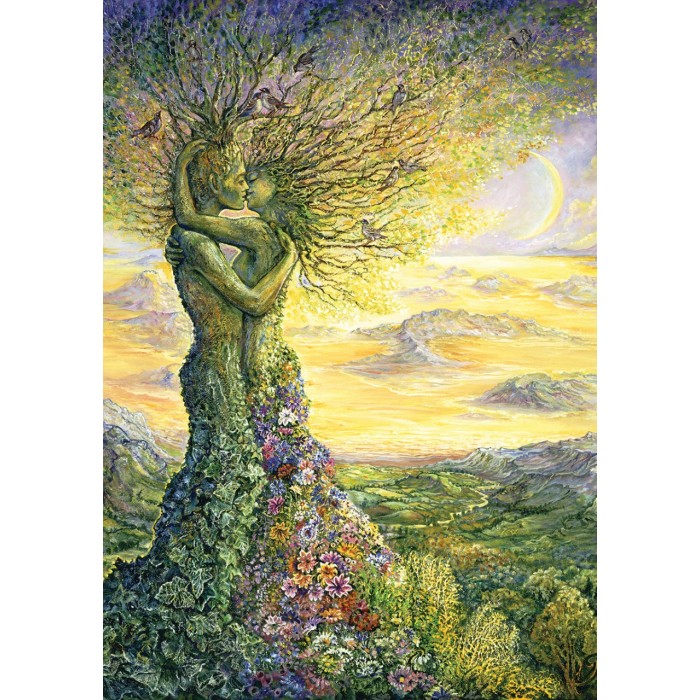What Are Art Puzzles?
Art puzzles, a wonderful blend of visual art and brain-teasing challenges, test your problem-solving skills. They often feature reproductions of famous paintings, intricate designs, or aesthetic photographs. Piecing these puzzles together requires keen observation and pattern recognition. Whether they come as traditional jigsaw puzzles or more modern variations, art puzzles can come in any size or level of complexity. They range from a few pieces for beginners to thousands of pieces for puzzle veterans.

Art puzzles go beyond merely assembling random pieces. Each piece represents a portion of a larger picture, and you must figure out where it fits within the grand scheme. With every correct placement, the beauty of the artwork slowly emerges. The end goal is not only to complete the puzzle but also to appreciate the artwork itself. It’s like slowly unveiling a masterpiece piece by piece.
Imagine handling pieces that come together to form Van Gogh’s ‘Starry Night’ or Monet’s ‘Water Lilies’. With each piece you place, you delve deeper into the artist’s vision. Art puzzles allow you to engage with timeless masterpieces in a hands-on way. They encourage you to look closer, notice details, and appreciate the nuances of color and texture that make up a great work of art.
Benefits of Solving Art Puzzles
Engaging with art puzzles offers several benefits that extend beyond the enjoyment of the activity itself. Here are some key advantages:
- Enhances Cognitive Abilities: Tackling art puzzles boosts brain functions. It improves memory, focus, and problem-solving skills.
- Promotes Relaxation: The process of assembling an art puzzle induces a meditative state. It reduces stress and promotes mental calmness.
- Stimulates Creativity: By studying and replicating the artwork, you exercise your creative thinking skills. This often sparks inspiration and personal creativity.
- Improves Visual-Spatial Reasoning: Fitting puzzle pieces together trains your brain to recognize patterns and shapes. This is beneficial for spatial understanding.
- Offers a Sense of Achievement: Completing an art puzzle provides a rewarding experience. It gives a sense of accomplishment and boosts self-esteem.
- Encourages Art Appreciation: Working closely with images of famous artworks increases appreciation for the details and nuances that define masterpieces.
- Provides a Social Opportunity: Art puzzles can be a fun group activity. They offer a chance to build relationships and collaborate with others.
- Cultural Education: Many art puzzles feature historical paintings. They provide a fun way to explore different cultures and periods in art history.
From improving mental faculties to offering a relaxing pastime, solving art puzzles is a valuable and multifaceted hobby. It’s no surprise that puzzles captivate so many enthusiasts around the world. Whether you’re looking to sharpen your mind or unwind after a long day, art puzzles offer benefits for everyone.
Essential Tools for Art Puzzle Enthusiasts
To excel in art puzzles, you’ll need more than just patience and skill. Here are essential tools that every art puzzle enthusiast should have in their arsenal:
- A Solid Surface: Start with a good foundation. A flat, sturdy board or a puzzle mat can provide this. It ensures pieces stay put as you work.
- Strong Lighting: Adequate lighting is crucial. It helps identify subtle color differences and fine details in the pieces.
- Puzzle Sorter: Keep organized with a puzzle sorter. This can be trays, boxes, or even bags. Sort by color, edge pieces, or however you prefer.
- Glue and Framing Kits: If you want to preserve your puzzle, glue and a frame are vital. They turn your completed puzzle into hangable art.
- Magnifying Glass: For puzzles with tiny details, a magnifying glass will be a lifesaver. It helps spot the nuances in the artwork.
- Reference Image: Keep the puzzle’s box or a printed image nearby. This serves as a guide as you place each piece.
- Tweezers: These can be handy for placing small, fiddly pieces without disturbing the rest of your puzzle.
Equipping yourself with these tools can greatly enhance your art puzzle experience. They facilitate a smoother puzzle-building process and help achieve precision in completing complex art puzzles.

Step-by-Step Guide to Solving an Art Puzzle
Solving art puzzles can be a rewarding task. It also requires a methodical approach for success. Here is a step-by-step guide to help you conquer your next art puzzle challenge.
Step 1: Choose the Right Surface
Start by selecting a flat, solid surface. It should be large enough for your puzzle. This keeps pieces from falling off as you work.
Step 2: Sort the Pieces
Lay out all the pieces face-up. Group them by color, pattern, or edges. Having a puzzle sorter can be a big help here.
Step 3: Build the Border
Locate the edge pieces and construct the puzzle’s frame. This gives you a clear area to work within.
Step 4: Section the Puzzle
Divide the puzzle into sections based on colors or details. Tackle one section at a time for better focus.
Step 5: Pay Attention to Details
Use the reference image to guide you. Look closely at the shapes and colors. A magnifying glass can aid in spotting small details.
Step 6: Persist and Place
Slowly fit pieces into place, one by one. Take breaks if needed but stick to it. Patience is crucial.
Step 7: Review and Adjust
Periodically step back and review. Make sure each piece fits correctly and adjust as necessary.
Step 8: Complete and Admire
Place the last piece and take a moment to admire your work. You’ve recreated a masterpiece.
By following these steps and using your essential tools, you’ll navigate through the process of completing an art puzzle with ease and enjoyment.

Tips for Improving Your Art Puzzle Solving Skills
Enhancing your skills in art puzzles can lead to even more enjoyment and success. Here are some tips to help you become a more proficient puzzle solver:
- Practice Regularly: Just like any skill, practice makes perfect. Work on puzzles often to sharpen your abilities.
- Develop a Strategy: Determine a tactic that works best for you. It might be starting with the edges or grouping by colors.
- Enhance Your Observation: Take time to really look at the pieces. Notice the subtle shades and patterns.
- Stay Organized: Use sorters to keep your pieces tidy. This can save time and reduce frustration.
- Improve Your Concentration: Reduce distractions while you puzzle. A quiet environment can help you focus better.
- Increase Puzzle Difficulty Gradually: Start with simpler puzzles and work your way up. This builds confidence and skills.
- Take Notes: Jot down what strategies work and what doesn’t. Refer back to these notes to improve.
- Use Time Management: Set puzzle-time limits for each session to stay motivated and on track.
Remember, patience and consistency are key. Keep challenging yourself but don’t forget to enjoy the process and the artwork you’re piecing together. Happy puzzling!
Common Challenges in Art Puzzles and How to Overcome Them
Art puzzles can present several challenges that may seem daunting to both beginners and experienced enthusiasts. Identifying these challenges and learning how to tackle them can greatly enhance your art puzzle-solving experience. Here are some common hurdles you might face along with strategies to overcome them:
- Difficulty Identifying Where Each Piece Fits: Sometimes the pieces may look very similar, making it hard to find their proper location. To overcome this, study the subtle differences in color and shape. Use strong lighting to help you spot these nuances and, if needed, employ a magnifying glass for closer examination.
- Pieces That Seem to Fit Anywhere: You may encounter pieces that seem to fit in multiple locations. In such cases, always refer back to the reference image and don’t be afraid to trial and test pieces in various spots. Patience is crucial here; take your time to ensure the right fit.
- Lost or Misplaced Pieces: Misplacing a puzzle piece can be frustrating. Keep all pieces in a puzzle sorter when not in use to prevent loss. If a piece goes missing, recheck areas where you’ve been working, or set aside dedicated space for stray pieces.
By being aware of these common art puzzles challenges and implementing the suggested strategies, you can improve your puzzle-solving skills, enjoy the process, and achieve the satisfaction of completing a beautiful work of art.
The Role of Patience and Strategy in Art Puzzles
The journey through art puzzles demands both patience and strategy. It’s a balancing act. Patience is vital. It lets you tackle each piece with calm focus. When pieces don’t fit, patience encourages you to keep trying. It reminds you that solving puzzles is a gradual process.
Strategy, on the other hand, guides your actions. It’s about planning your moves. With a good strategy, you group pieces, build frames, and follow patterns. You map out your approach before diving in. This makes the overall task less daunting. It saves time and effort in the long run.
Here’s how to use patience and strategy:
- Take Your Time: Rushing can lead to mistakes. Don’t hurry. Enjoy the process of solving puzzles.
- Have a Plan: Before starting, decide on your strategy. Will you sort by color or tackle the edges first?
- Adapt as You Go: If a strategy isn’t working, change it. Be willing to try new approaches.
- Keep Your Goal in Mind: Remember why you’re doing the puzzle. It helps to stay patient and motivated.
- Learn from Each Puzzle: Every art puzzle is different. Use what you learn from each to refine your strategies.
Combining patience with a good strategy can make art puzzles more enjoyable. It turns a challenging activity into a rewarding one. You grow your problem-solving skills while appreciating fine art. Stick with it, and watch your puzzle-solving abilities soar.
Finding and Choosing the Right Art Puzzles for You
Choosing the right art puzzles can make your experience more enjoyable. Here are some tips for finding puzzles that suit your interests and skill level:
- Consider the Artwork: Look for puzzles featuring artists or styles you love. Your passion for the art will fuel your dedication to the puzzle.
- Check the Difficulty: Start with puzzles that match your skill. Beginners should opt for fewer pieces, while experts may enjoy a thousand-piece challenge.
- Quality Matters: Good quality puzzles fit well and last longer. Check reviews to ensure you’re getting a durable product.
- Size and Space: Consider how much space you have. Ensure the puzzle’s size is appropriate for your available area.
- Puzzle Material: Wooden puzzles last longer but may cost more. Cardboard puzzles are common and more affordable.
- Color Complexity: Choose a puzzle with a color palette that appeals to you. Some find vibrant puzzles exciting, while others prefer muted tones.
- Educational Value: For added value, pick puzzles that teach you about art history or technique.
With these points in mind, you’re ready to find art puzzles that not only challenge you but also resonate with your personal taste in art. Remember the joy of the process is as important as the challenge itself. Keep looking until you find that perfect puzzle that promises hours of engaging fun as you piece together a masterpiece.
